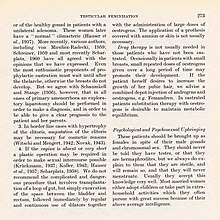Intersex
![]()
This article discusses false hermaphroditism in humans - for false hermaphroditism in general, see pseudohermaphroditism.
Intersexuality refers to very different clinical phenomena with different biological causes, such as deviations of the sex chromosomes or genetically caused hormonal developmental disorders. Intersexuality is classified as a "disorder of sex development" (DSD). However, DSD also includes cases that do not present with ambiguous genitals at birth. In the literature, the frequency of ambiguous genitalia at birth is estimated to be between 1:4500 and 5500, others estimate the number of intersex persons in Germany to be about 0.2% of the population or 0.007% of newborns. According to extrapolated registrations by registry offices in Germany, the newer option of registering the gender entry "diverse", which has been possible since 22 December 2018, was used in about 150 cases until May 2019 (0.00019 % of the population), which is equal to an estimate of 150 intersex newborns per year.
The ICD-10-GM-2018 of the German Institute of Medical Documentation and Information (DIMDI) also lists congenital malformations of the genital organs, in particular indeterminate sex and pseudohermaphroditism, in Chapter XVII (Congenital malformations, deformities and chromosomal anomalies).
Affected people mostly reject the pathologizing medical term of disorder and refer to themselves as intersexual people, intersex, intergender people. Since 2015, the German Medical Association also speaks of "variants/disorders of gender development" in order to avoid a discriminatory pathologisation from the perspective of those affected. The spelling inter* is also used, whereby the asterisk * stands for the aforementioned and other possible self-designations. Sometimes the term third gender is also used, but this is not accepted by everyone. In the English-speaking world, it can also be observed that intersex people are increasingly using the historical term "hermaphrodite" again as a self-designation, especially as a response to the imposed "disorder", even creatively rhyming with "human rights". The newsletter of the now defunct ISNA was called Hermaphrodites with Attitude.

Gender symbol for intersex

Flag for Intersex (Morgan Carpenter, 2013).
Biological and medical aspects
Difference to transgender and transsexuality
The definition of intersexuality has to be distinguished from "transgender" and from "transsexuality":
- Transgender people are people who feel that their assigned gender describes them incorrectly or inadequately, or who also fundamentally reject any form of gender assignment or categorization. Some intersex people are transgender. While in some organisations and alliances transgender and intersex people work together, as many similarities are seen, other intersex people reject any cooperation with transgender people.
- Transsexual people have so far been defined by medicine as biologically unambiguous, but feel they belong to the other binary gender than the one assigned at birth. For the medical diagnosis "transsexuality", intersexuality is therefore formally an exclusion criterion in the ICD-10. With the DSM V and the concept of "gender dysphoria" this changed and intersexuality (DSD) was included in the book of mental disorders. In ICD-10, as of the latest update on November 1, 2019, it is still listed as "transsexualism" under personality and behavior disorders, gender identity disorders. In the draft version "ICD-11", instead of being listed as a personality disorder, it will be included as "Gender Incongruence" (HA60) under Conditions related to Sexual Health; ICD-11 is expected to come into effect in 2022.
The diagnosis "intersexuality" can only be made by several examinations, among others a chromosome analysis (karyogram). Nevertheless, it happens again and again that intersexual people who change the gender role do not even find out that they are actually intersexual and therefore are treated medically and according to the Transsexual Act (TSG) as "transsexual" persons.
Causes
Ambiguities of body sex are biologically possible because the sex organs in the female and male embryo arise from the same predispositions (sex organ). The following variations may occur during physical development:
- Chromosomal variations: Instead of the average most common karyotypes 46,XX (female) and 46,XY (male), there are also variants 45,X, known as Turner syndrome with a female phenotype, and 47,XXY, Klinefelter syndrome with a male phenotype, among others, as well as mosaics mos45,X/46,XX, mos45,X/46,XY, and chimerism chi46,XX/46,XY. The chromosomal sex is the basis of all further sex expressions.
- Gonadal variations: lack of development (agonadism); formation entirely or partially into so-called striated gonads (non- or only partially developed gonadal dysgeneses); ovarian and testicular tissue components in either the same (ovotestes) or separate gonads (true hermaphroditism/ hermaphroditism verus).
- Hormonal variations: Abnormal serum levels of sex hormones and their precursors, sometimes with consequences such as gynecomastia (breast development in men) or hirsutism (very strong body hair) in women, but sometimes also affecting sexual differentiation as a whole. This can have various causes (chromosomal, gonadal and nephrological variants, enzyme defects).
- Anatomical variations: From gender peculiarities with non-specific causes to more culturally determined assessments (basis of social gender) such as "too small" penis or "too big" clitoris, a great many variations are known.
Many intersexual "syndromes" do not consist of only one detectable variation, but arise in the interaction of several factors, for example in the case of the androgen receptor defect (AIS, androgen resistance). Here, complete androgen resistance or complete AIS (CAIS, from complete AIS), partial androgen resistance or partial AIS (PAIS) and minimal androgen resistance or minimal AIS (MAIS) are to be distinguished. In complete androgen resistance (CAIS), for example, testes develop in a fetus with XY chromosomes and may remain in the body. However, the receptors for testosterone are absent, so a "female-looking" external genitalia (but without female internal organs) develops; the sex of upbringing is then usually female. Intersexual people with CAIS - unlike PAIS - are often not recognized until puberty. With less pronounced resistance, according to the medical dictionary Pschyrembel Wörterbuch Sexualität, there are different formations of the male sexual organs (hypospadias, cryptorchidism, azoospermia) and physical feminization (e.g. gynecomastia, see Reifenstein syndrome).
In an XY-chromosomal person with Swyer syndrome due to the deletion of the SRY gene, the vagina and uterus are also formed, but in tissue samples there is no barr body (sex chromatin), which is found in every XX-chromosomal woman. Thus, in an XY-linked Swyer syndrome, the vagina and uterus are male. People with Swyer syndrome also often do not become noticeable until puberty.
In an XY-chromosomal child with a genetically determined 5α-reductase deficiency, a transformation of testosterone into the biologically much more active form of dihydrotestosterone is not possible to a sufficient extent in the cell lines of the urogenital sinus and genital tubercle. Therefore, in this case, the complete sex differentiation of the male embryo does not take place. This child looks like a girl at birth because the primary sexual characteristics are more like a vulva. With the onset of puberty, the body produces a significantly increased amount of testosterone and sometimes some dihydrotestosterone. As a result, a rather small male penis is formed from the previously ambiguous to slightly enlarged clitoris. A malformation of the urethra, the so-called hypospadias, occurs more frequently. The weakly developed prostate now usually increases its volume, but remains underdeveloped. The testicles, which were previously located in the abdomen, often descend into the forming scrotum. This development can sometimes lead to full reproductive capacity without medical assistance.
Also to be considered is the presence of a prostate in almost all XY chromosomal individuals with intersexual syndromes.
Frequency
Intersexuality is not a medical diagnosis, but a summary term for very different clinical phenomena with different biological causes, such as deviations of the sex chromosomes, genetically or drug-induced hormonal developmental disorders that are not sex chromosomal, and accidents. Exact epidemiological data on intersexual children and adults in Germany do not exist at present, there are only estimates. The malformation monitoring Saxony-Anhalt gives an order of magnitude of 0.5 to 1 per 1000 children. In a 2017 decision, the Federal Constitutional Court cites the 1:500 estimate from the Pschyrembel Clinical Dictionary (2014 edition) as an example. The largest group includes those with adrenogenital syndrome (AGS, in English CAH for Congenital Adrenal Hyperplasia) with an incidence of about 1:4000 to 1:9000 births.
To exclude intersexuality, a detailed physical examination including chromosome analysis is necessary (karyogram). The social scientist Heinz-Jürgen Voß criticises that many factors have an effect on the development of gender and that gender is individual and manifold. Assignments to intersexuality and "Disorders of Sex Development" (DSD) would be pathologized from the position of normative two-gender order.
Medical gender reassignment or sex determination
From the 1960s onwards, gender reassignment surgery was often performed on children with an ambiguous gender as early as the neonatal period. These included, for example, the creation of a neovagina, the reduction of the genitals to an unambiguous, usually female size (especially clitoris reduction) and the removal of any testicles, the latter usually with subsequent contra-chromosomal hormone replacement therapy.
These interventions were mostly carried out without the effective consent of the parents, in particular without sufficient information about the risks associated with these interventions and medically necessary follow-up treatments, and often also without a compelling medical indication. This was in contradiction to the importance of these measures as irreversible interventions in the core area of personal identity and physical integrity. Others whose intersexuality was not recognized until adulthood - such as Lucie Veith - had their newly discovered diversity taken away by surgery. They later denounce the injuries inflicted on them just to maintain the female-male dichotomy and see themselves as forcibly transsexualized or castrated.
In a statement in 2012, the German Ethics Council stated that the situation of intersexual people is characterized to a large extent by experiences of suffering, disregard on the part of medicine, lack of sensitivity of the social environment, administrative and bureaucratic obstacles and widespread social ignorance of the reality of life. Regarding the legal assessment, he states that according to the Prussian General Land Law of 1794, parents first determined the sex of the child in case of ambiguity. At the age of 18, however, a hermaphrodite had the right to freely choose his or her own sex (the so-called Zwitterparagraf). With the introduction of personal status law at the end of the 19th century, the right to choose became an ex officio assignment into the categories "male" and "female". The reason: Because it was proven that "self-fertilization is impossible [...] the occurrence of true hermaphrodites in humans has been directly denied by most researchers until now, and accordingly, in German legislation from 1900 onwards, the legal paragraphs formerly used for questions concerning hermaphrodites were completely deleted."
Abroad, however, several cultures allow another gender category (for example, in India, Brazil, Kosovo, North America and Indonesia). In Australia, a third category for gender (X for indeterminate) was introduced in the passport in 2011. In Belgium, gender can be registered as indeterminate after the birth of a child. In Germany, since the 2009 revision of the Civil Status Act, it has been possible to waive the requirement to include gender on the birth certificate upon request (Section 59(2) PStG).
Subsequently, a resolution recommendation of the Interior Committee of the German Bundestag provided for a further amendment of the civil status law, which addressed the problems on the subject of "intersexuality" and clarified that the sex indication in the birth entry can remain open if this is not established beyond doubt. A corresponding new provision in Section 22 (3) PStG has been in force since 1 November 2013. Since 22 December 2018, in addition to leaving the gender entry open, the indication "diverse" can also be chosen.
Since then, medically unjustified measures for genital reassignment shortly after birth have become unnecessary. Depending on the concrete need for treatment in the individual case, an individual, balanced therapy should take place, which integrates not only anatomical and physiological, but also psychological, psychosocial and legal aspects. Indication and therapy require an interdisciplinary team. A 2011 guideline from the Society for Pediatrics and Adolescent Medicine takes this into account by assessing surgical interventions in infants with more restraint. Nevertheless, there has been no significant decrease in gender-norming operations on newborns in the following years.
On 22 May 2021, a general ban on genital reassignment surgery in intersex children who are unable to consent came into force in Germany (see below).

"They should never be told..." ( Internationally published treatment recommendations for androgen resistance from Switzerland, 1963.
Legal aspects
![]()
This article or paragraph presents the situation in Germany. Help describe the situation in other countries.
Since the end of the 19th century, only "male" or "female" could be entered in the birth register in Germany. There was increasing criticism that this compulsion discriminated against the intersexual minority. In February 2012, the German Ethics Council proposed to the German Bundestag "that intersexual people may also choose the entry 'other'". The Council considered a compulsion to specify "male" or "female" as an "unjustifiable encroachment on the right of personality and the right to equal treatment".
On 7 May 2013, the Bundestag passed an amendment to the Civil Status Act. Since 1 November 2013, the newly inserted section 22 para. 3 PStG reads: If the child cannot be assigned to either the female or the male sex, the civil status case shall be entered in the register of births without such indication. On the other hand, the law did not allow the entry of an intersex person in the birth register as "inter" or "diverse". However, on 10 October 2017, the Federal Constitutional Court ruled that it violated the personal rights of intersexuals if they were not allowed to be listed in the birth register as "inter", "diverse" or by any other positive designation. It gave lawmakers until the end of 2018 to create new legislation that would allow such registration. The federal government submitted a draft in line with the ruling on August 15, 2018. "The bill here provides that the registrar may enter the indication 'diverse' in addition to the variants already provided for." Since December 22, 2018, the gender "diverse" is in the Civil Status Act.
A draft law providing for a general ban on operations on children who are incapable of giving consent and have variants of sex development was passed in the Bundestag on March 25, 2021, essentially unchanged. According to a report in the German Medical Journal, the law is intended to strengthen the self-determined decision-making of children and adolescents and avoid possible damage to their health. A surgical change of sexual characteristics would then only be allowed to be carried out - even with the consent of the parents - if the intervention cannot be postponed until the child has made a self-determined decision. The majority of legal scholars and psychologists consulted are in favour of the approach. The Federal Chamber of Psychotherapists also demands the obligatory participation of an intersexual counsellor in the assessment before a possible intervention. The draft and the finally passed law were sharply criticized by the Organization Intersex International (OII) Germany, as they provide too many exceptions and do not sufficiently protect intersexual children and adolescents from gender reassignment surgery. The law came into force on 22 May 2021.
Questions and Answers
Q: What are intersex variations?
A: Intersex variations are when a person is born with sex characteristics that are in between those of typical males and females.
Q: What is a hermaphrodite?
A: Hermaphrodite is a term that is often conflated with intersexual, but while all hermaphrodites are intersexual, not all intersexual people are hermaphrodites.
Q: What is the clinical term for intersex variations?
A: The clinical term for intersex variations is "disorders of sex development" (DSD), but this term is controversial.
Q: What might be atypical about an intersex individual's genitalia?
A: An intersex individual's genitalia may be atypical in some way, and it can be difficult to determine if they are genetically male or female.
Q: What are some secondary sex characteristics that intersex people may have?
A: Intersex people may have male and/or female secondary sex characteristics, such as body shape.
Q: Are there more subtle forms of sex anatomy and sex chromosome differences?
A: Yes, there are many more subtle forms of sex anatomy and sex chromosome differences that may not even show physically, or may not be detected until later in life.
Q: Is it possible that an intersex variation may never be detected in an individual's lifetime?
A: Yes, it is possible that an intersex variation may never be detected in an individual's lifetime, though as technology gets more advanced, the chance of detection may increase.
Search within the encyclopedia